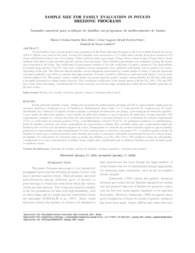Sample size for family evaluation in potato breeding programs.
Sample size for family evaluation in potato breeding programs.
Author(s): DINIZ, M. C. D. R.; PINTO, C. A. B. P.; LAMBERT, E. de S.
Summary: Clonal families from a broad genetic base population in the Potato Breeding Program at the Universidade Federal de Lavras (UFLA), Brazil, were used in this trials. Twenty-five families were assessed in a 5 x 5 triple lattice design. Each plot consisted of 30 clones distributed in three rows of ten plants. Tuber yield per plant, percentage of large tubers, mean weight of large tubers, mean medium-sized tuber weight and tuber specific gravity were measured. Three hundred experiments were simulated varying the family sizes from three to 90 clones. The coefficients of experimental variation (CVe), the coefficients of genetic variation (CVg), heritabilities for family mean and the CVg/CVe ratio were estimated. Genetic parameters were stabilized with family sizes as small as six clones, depending on the trait. This indicates that the families can be adequately represented by a small sample of clones. Using the maximum curvature method it is possible to conclude that approximately 30 clones would be sufficient to represent each family, even for traits with the highest CVe. The genetic variance within family was greater than the genetic variance among families for all traits, indicating a favorable potential for within family selection. The correlation coefficients of the family means with the 5%, 10%, 15% and 20% best clones from each family, considering the five traits assessed, were always high, meaning that within the best families generally are the best clones.
Publication year: 2006
Types of publication: Journal article
Unit: Embrapa Soybean
Keywords: Batata, Clone, Solanum Tuberosum
Observation
Some of Embrapa's publications are published as ePub files. To read them, use or download one of the following free software options to your computer or mobile device. Android: Google Play Books; IOS: iBooks; Windows and Linux: Calibre.
Access other publications
Access the Agricultural Research Database (BDPA) to consult Embrapa's full library collection and records.
Visit Embrapa Bookstore to purchase books and other publications sold by Embrapa.

